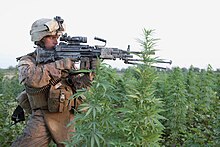Cannabis and the United States military

| Part of a series on |
| Cannabis |
|---|
 |
Cannabis usage is currently prohibited in the United States military, but historically it has been used recreationally by some troops, and some cannabis-based medicines were used in the military as late as the twentieth century.
Military medicine
[edit]In 1909, a military manual from the Mounted Service School in Fort Riley recommended cannabis indica for treating abdominal pains in horses, or to supplement ether for treating spasms.[1] During World War I, military doctors recommended that the American Expeditionary Force carry cannabis indica tablets to treat headaches, insomnia, and cramps.[2]
Drug use in Panama and investigations
[edit]Some of the earliest reports of recreational cannabis use in the military came from the Panama Canal Zone in 1916, where troops were noted to be using the drug.[3][4] Also in 1916, thousands of US troops used marijuana while in Mexico on General John Pershing's punitive expedition against Pancho Villa (1916–1917).[5] In 1921, the commanding officer of Fort Sam Houston in San Antonio, Texas, prohibited the use of cannabis on the base.[6]
A 1933 report by the U.S. Army Medical Corps published in the publication Military Surgeon, titled Marijuana Smoking in Panama, based on a study of U.S. Army personnel in the Panama Canal Zone, found that cannabis was generally not addictive and was less harmful to soldiers than alcohol.[7][8] The report recommended that use of cannabis on military bases should continue to be prohibited, but outside of these areas there should be no further restriction.[8]
Industrial hemp
[edit]The Rens Hemp Company of Brandon, Wisconsin, closed in 1958, was the last legal hemp producer nationwide in operation following World War II.[9] Prior to its 1957 shutdown, Rens had been the primary provider of hemp rope for the United States Navy.[10]
Edgewood Arsenal human experiments
[edit]From the 1950s to the 1970s, Edgewood Arsenal conducted experiments on human subjects with cannabis and its derivatives.[11][12] One study indicated "no loss of motivation or performance after two years of heavy (military sponsored) smoking of marihuana."[13]
Vietnam War
[edit]Though alcohol was the drug most commonly used by American troops in the Vietnam War, cannabis was the second-most common. Initially rates of usage among deployed soldiers were comparable to those of their stateside peers, with 29% of troops departing Vietnam in 1967 reporting having ever used marijuana in their lives. A 1976 study however showed that from 1967 to 1971, the proportion of troops having used marijuana peaked at 34% before stabilizing to 18%, while the number of troops who had used cannabis prior to deployment stayed around 8%.[14] Cannabis use by troops in Vietnam was generally dealt with using Article 15 non-judicial punishment in units such as the 101st Airborne.[15]
During the Vietnam War period, cannabis use also became common among US forces in the United States and in Europe, with a 1971 article claiming that over 1,000 midshipmen at Annapolis Naval Academy used cannabis, and a survey in Germany showing that half of the soldiers in the surveyed battalion were regular cannabis users.[16]
References
[edit]- ^ United States. Mounted Service School, Fort Riley, Kan (1909). The army horse in accident and disease: edition: 1909. A manual prepared for the use of students of the Training school for farriers and horseshoers. Govt. print. off. pp. 110–.
{{cite book}}: CS1 maint: multiple names: authors list (link) - ^ Brendan I. Koerner (May 29, 2008). Now the Hell Will Start: One Soldier's Flight from the Greatest Manhunt of World WarII. Penguin Publishing Group. pp. 87–. ISBN 978-1-4406-3387-4.
- ^ The International Journal of the Addictions. M. Dekker. 1982.
- ^ Richard E. Hardy; John G. Cull (June 1973). Drug dependence and rehabilitation approaches. Thomas. p. 91. ISBN 978-0-398-02690-5.
- ^ Curtis Marez (2004). Drug Wars: The Political Economy of Narcotics. U of Minnesota Press. pp. 111–. ISBN 978-0-8166-4060-7.
- ^ Charles H. Whitebread (1974). The Marijuana Conviction: A History of Marijuana Prohibition in the United States. Lindesmith Center. p. 35. ISBN 978-1-891385-06-3.
- ^ Ruth C. Stern & J. Herbie DiFonzo, The End of the Red Queen's Race: Medical Marijuana in the New Century, Quinnipiac Law Review, Vol. 27, p. 688.
- ^ a b Marijuana Smoking in Panama, Military Surgeon, Vol. 73 (1933).
- ^ TAPPI Journal. Technical Association of the Pulp and Paper Industry. 1999. p. 114.
- ^ John Roulac (January 1, 1997). Hemp Horizons: The Comeback of the World's Most Promising Plant. Chelsea Green Pub. p. 59. ISBN 978-0-930031-93-0.
- ^ United States. Congress. Senate. Committee on the Judiciary. Subcommittee to Investigate Juvenile Delinquency (1975). Marijuana Decriminalization: Hearing Before the Subcommittee to Investigate Juvenile Delinquency of the Committee on the Judiciary, United States Senate, Ninety-fourth Congress, First Session ... May 14, 1975. U.S. Government Printing Office. pp. 942–.
- ^ Understanding the Social Costs of Marijuana Laws: With Emphasis on the Medical Aspects. The Committee. 1974.
- ^ Joseph W. Jacob; Joseph W. Jacob B. a. M. P. a. (October 2009). Medical Uses of Marijuana. Trafford Publishing. pp. 102–. ISBN 978-1-4269-1540-6.
- ^ Roy W. Menninger; John C. Nemiah (November 1, 2008). American Psychiatry After World War II (1944-1994). American Psychiatric Pub. pp. 23–. ISBN 978-1-58562-825-4.
- ^ Judge Advocates in Vietnam: Army Lawyers in Southeast Asia, 1959-1975. DIANE Publishing. 2003. pp. 66–. ISBN 978-1-4289-1064-5.
- ^ James Westheider (2011). Fighting in Vietnam: The Experiences of the U.S. Soldier. Stackpole Books. pp. 173–. ISBN 978-0-8117-0831-9.
